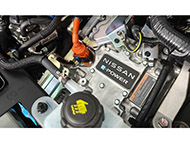Climate change is at the heart of the transformation of the automotive industry. As manufacturers strive to reduce greenhouse emissions, the road to carbon neutrality is proving to be anything but a straight line, given the diverse and far-reaching challenges posed by different markets.
While the acceptance of alternative energy vehicles, particularly electrified models, has been strong in certain regions. As the world’s first mass producer of BEVs since 2010 with over a million units in sales to date, Nissan has a clear vision on how to navigate this transformational period.
The role of e-POWER in a balanced portfolio
As set out in the The Arc Business Plan, Nissan targets volume growth through a tailored regional strategy in preparation for the transition to BEV, leveraging on a balanced portfolio of ICE, hybrid and BEV models, with a measured increase of new electrified options in the model mix.
Every new Nissan model to be introduced in key markets by the early 2030s will be electrified, this will be spearheaded by the twin-interconnected pillars of electrification at Nissan – a growing range of new BEVs to cover more segments, alongside an expanding line-up of e-POWER models to drive transformation. Additionally, powertrain integration and modularisation between BEV and e-POWER models will result in cost parity with ICE-powered models in the near future.
Achieving life cycle CO² reduction through e-POWER
Nissan conducts life cycle assessment (LCA) to quantitatively evaluate environmental impact, not only during vehicle use, but at all stages, including raw material extraction, manufacturing, transport as well as end-of-life vehicle recycling.
Compared to their petrol-powered counterparts, e-POWER models such as the Kicks e-POWER emits less life cycle CO² output, courtesy of its second-generation e-POWER system which not only offers a more responsive and refined performance, but also a lower environmental impact.
As the internal combustion engine of an e-POWER system only has an energy-generating role and operates under fixed conditions, it is able to consistently achieve a high level of thermal efficiency which improves overall fuel efficiency while reducing tailpipe emissions and CO² output.
In the on-going development of next generation Nissan e-POWER systems, a global milestone in engine thermal efficiency was achieved during testing – a technological breakthrough with the potential to markedly improve fuel efficiency and to further reduce CO² outputs of forthcoming e-POWER systems. Nissan is fully committed to accelerating innovation in electrification technologies such as e-POWER as markets transition to BEVs.
About e-POWER in Malaysia
The e-POWER drive system is a technology unique to Nissan – it is 100% electric motor-driven utilising a petrol engine to produce energy to charge its Li-ion battery pack and to power an electric motor to drive the wheels. It offers instant torque and responsive performance just like an EV, but without range anxiety and the need to plug in and charge. Compared to an ICE-powered vehicle, the e-POWER system has lower tailpipe emissions and running costs, it utilises regenerative braking to reclaim energy and offers single-pedal driving. Nissan plans to launch the all-new KICKS e-POWER model in Malaysia in December 2024.
To learn more about the ground-breaking e-POWER technology in anticipation of the first-ever e-POWER model in Malaysia, visit the dedicated Apa-e? webpage found on Nissan Malaysia’s official website (https://nissan.com.my/experience-nissan/e-power/). Here you can indulge in all-things e-POWER and even win exclusive Nissan merchandise by participating in the Apa-e? Quiz! Also, keep an eye out for on-ground Apa-e? roadshows scheduled in the month of November, 2024.



